Naughty Norman. Not really. Unconscious of what he was doing, or in the grip of forces otside his control. Not likely. Ostensibly, it was a play on innocence, but it was effectively not much different than a J.D. Salinger, Isaac Bashevis Singer and other artists working the vein of American mythology, of interpreting this phenomenon of America imbued with the new and innocent, what could be termed the shock of the new. That there was, and it seems highly plausible, intentional depictions of homoeroticism in the work is a reflection that incest and sexual taboo is and has always been an undiscussed aspect of American culture and Western culture in particular, washed over by what can be termed plausible necessities to deal with trauma and channel memeory into spheres of the fantasy and imaginary that ideally are less toxic and serve as procastinators to those flashes of reckoning.
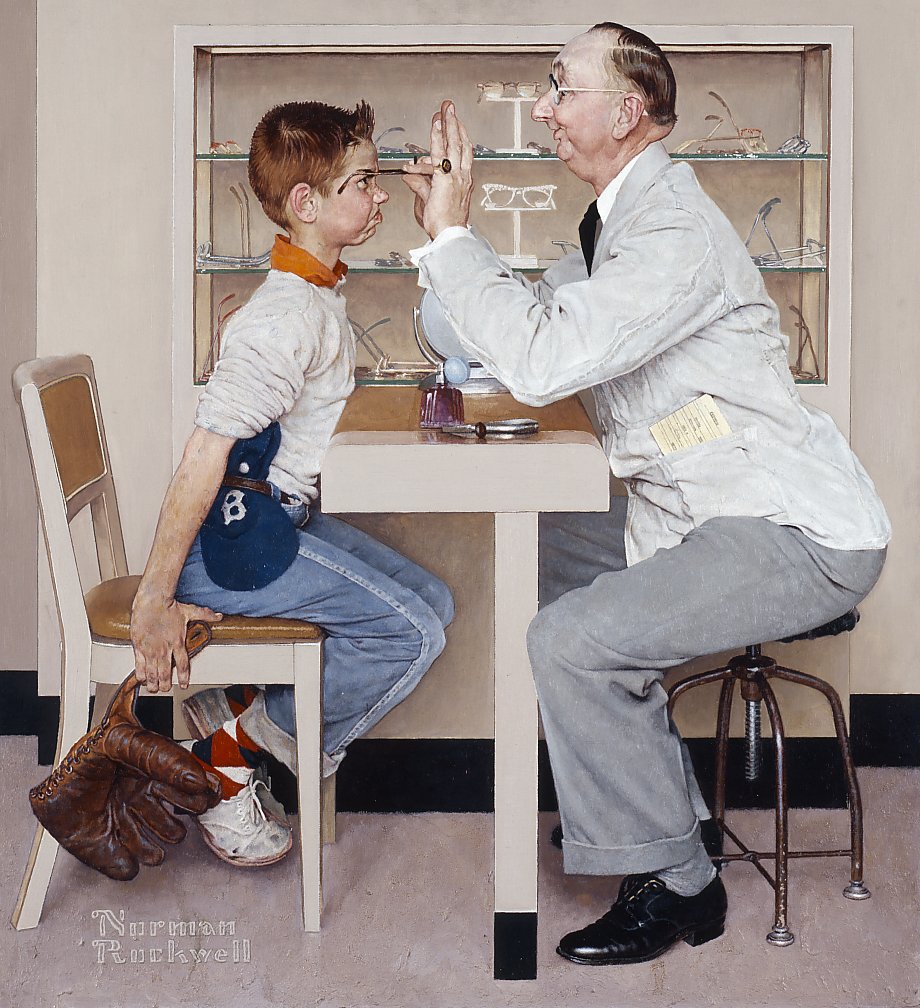
---Norman Rockwell (American, 1894-1987) The Oculist, 1956 Oil on canvas Museum Purchase, 1957, A934 Rockwell became one of America's best loved artists on the basis of his illustrations for American magazine covers. He is best known for the 322 Saturday Evening Post covers he created between 1916 and 1963, such as this painting, which appeared on the May 19, 1956 issue.--- Read More:http://hagerstownblogs.com/museum_of_fine_arts/2011/05/highlights-from-the-collection-norman-rockwell-the-oculist.html
Another oddity, or watering of the quirk, is Rockwell’s substantiation of the common misrepresentation that Americans are naturally and incurably a humorous, essentially warm people. This is a form of revisionism of the American psyche to mitigate the paranoia and fear that has infected the body politic since its inception. Not to much a moral tone, as a psalm to the oppressed and victimized. After all, the gift of laughter, the capacity for sublime humor is intrinsic to oppressed people, more generally in their relationship with life’s absurdities. The poor, and the legions of “new whites” immigrants aspiring to the fold all seeking to negotiate the vagaries of American identity posited from the position of white people and the discovery of personal whiteness. The secular religion of whiteness.
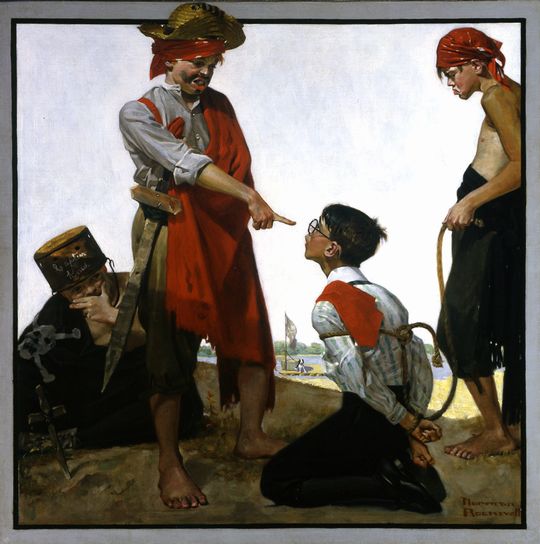
---Norman Rockwell's Cousin Reginald Plays Pirates © 2010 Images by the National Museum of American Illustration and the American Illustrators Gallery--- Read More:http://criticscircle.org.uk/visual-arts/?ID=171
To this extent, Rockwell explored the limits of boundaries, plausible settings, realms of encounter that held potential for the transgressive. These are pop culture dilutions of say Pieter Bruegel and Bosch, but the themes are there if you sand away the varnish of the commercialism. The representation of the non-traditional industrial age male; the non athletic, foppy, marginalized was not that far removed from the Baudelaire and Rimbaud bohemian, just a bit more sucky and even shadowy a figure. His touches of the androgynous was was attracted Bowie to look to Rockwell for the cover of Young Americans. So, there are complicated concepts at work here, suggestive parries into the the underside of that wholesome image. For Mickey Mantle that heartland hero, there was Mickey drunk driving and excessive in life’s pleasures.
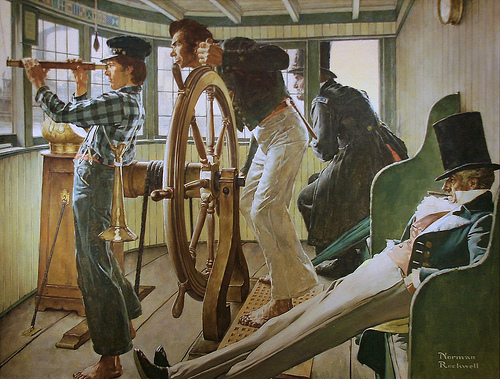
---The homoeroticism of "River Pilot" leaps right off the canvas--- all those emphatically phallic horizontals; how the gaze of the fellow in the top hat travels straight to the younger man's rear; the old man's suggestive cigar. "Back to Civvies" takes easily to a gay reading, too, what with its insistence on a nice rear view.--- Read More:http://voices.washingtonpost.com/arts-post/2010/11/norman_rockwell_gay_icon.html
From a very good article discussing homoeroticism in Rockwell ( see link): It consists of images where the sexual content is entirely obscured and overwhelmed by the obviously non-sexual or even highly moral content of the subject matter. With such works one frequently has to wonder whether the artist was aware of the sexual aspect of the image to begin with. To further this ambiguity, when such content is pointed to, it is often denied. Consider many religious images, a crucifix for example. Many crucifixes are clearly homoerotic, but the primary message is so important that the nakedness and sensuous nature of the pose are almost never even noticed. It is into this murky category that Norman Rockwell’s paintings fall. That is, the homoeroticism is veiled and even justified by the apparent necessity of the pictures’ story telling content….
…To demonstrate this idea however requires illustration but that is an easy task as Rockwell’s homoerotic images are not in the least hard to come by – in fact, if I were to mention them all it would become redundant, so I focus on his Post covers, beginning with the earliest. The homoerotic aspect of his work is immediately apparent in these early covers and continues throughout his long career. Consider eight covers done in succession from June 14 1919 until January 17, 1920 during the first year of his work for the magazine. Of these eight images, seven feature men or boys in either suggestive or revealing poses. …Read More:http://richard-britell.blogspot.com/2007/08/homoeroticism-in-paintings-of-norman.html
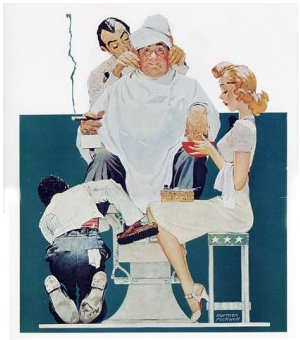
---The perfectly-painted butt of which I speak is seen in the May 18, 1940 Post cover illustration titled, "The Full Treatment", A middle aged man with legs spread sits in a barber chair. ...That is, the activity seems to require that the butt be portrayed in this suggestive way. So to be quite specific with this piece, the take-away message is that this man will get to enjoy every type of sexual pleasure. He will put his fingers in the woman, the red bowl suggesting her vagina. He will have at his beck and call the black man's rectum and he will be stroked to pleasure by the boy as indicated by the motions of the shoe brush. Lastly, consider the face, which expresses his anticipatory pleasure in these expectations of delight. ...Rea
re:http://richard-britell.blogspot.com/2007/08/homoeroticism-in-paintings-of-norman.htmlPerhaps a revealing aspect of the value of Rockwell is onthe art market itself. Some works of Rockwell have nearly equal commercial value as that of Andy Warhol and Francis Bacon, showing that in terms of monetary value there has been a weakening of the structures that held popular commercial and fine art segregated, which coincided with the art of the three formentioned artists. The critical theory would infer that iconographic sources, the inferred public audience and handling of the material is un-nuanced , naive and perhaps overly simplified from a fine art perspective may be found to be wanting, and in the case of Rockwell at least, more challenging than meets a traditional critical eye with an inclination for antipathy towards pop culture and the disruptive patterns characterized in a post Marcel Duchamp world.
ADDENDUM:
Again, ( see link) : If I were called upon to speculate about his biography however, I would suggest that this great painting may be some sort of a self portrait, in which we glimpse, in metaphor, an indication of something that happened to him as a child, some invasion of his childhood chastity by an adult male, perhaps a Doctor, or a character like the Policeman in the runaway. Whatever the case, I believe that Rockwell may have been violated in some way by someone in authority, and that, like the boy who received the shot, he did not accept the experience and began examining the world in which he lived, looking for clues, leaving no rock unturned in a search of explanations.Read More:http://richard-britell.blogspot.com/2007/08/homoeroticism-in-paintings-of-norman.html
Richard Halper ( see link):More interesting from my perspective is the fact that the same society addicted to mass-produced innocence was equally addicted to mass-produced sleaze. For every Mr. Smith Goes to Washington there were swarms of “Killer Bs”: cheap, noir films filled with violence, gangsterism, and sex. Films with titles like They Made Me a Killer, Kiss the Blood Off My Hands, and Bad Blonde. In 1946, the year in which It’s a Wonderful Life appeared, twenty-six Killer Bs left the hive. For every wholesome Disney comic there were others such as Teenage Dope Slaves, Murder, Inc., and Crimes by Women. For every Rockwell cover on the Saturday Evening Post there were mountains of pulp fiction, men’s and crime magazines, whose lurid cover art often depicted graphic violence and sadomasochism. Some very strange things crawled around in the basement of postwar culture, and it was a big basement—bigger than the house. No doubt the “two cultures” were often patronized by different audiences, but many people who saw a Capra or Doris Day film one day doubtless saw The Mad Ghoul or The Whip Hand the next, and many who displayed the Ladies’ Home Journal or the Saturday Evening Post on their coffee tables stashed copies of less wholesome reading matter elsewhere in their homes. I am less interested in the hypocrisies produced by this culture than in the compartmentalization of mind it bespoke—the fact that people could take the products of the innocence industry seriously while also wallowing in less savory fare. Read More:http://www.press.uchicago.edu/Misc/Chicago/314405.html


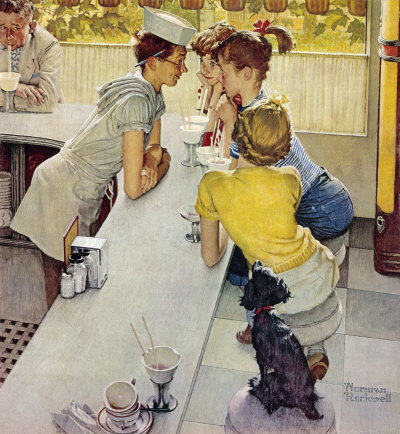
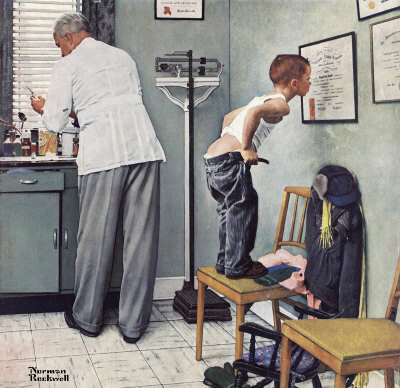



 COMMENTS
COMMENTS